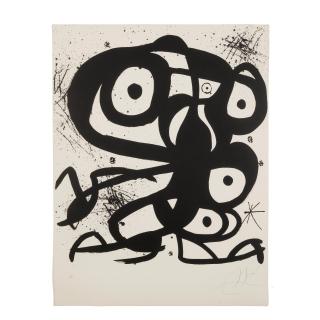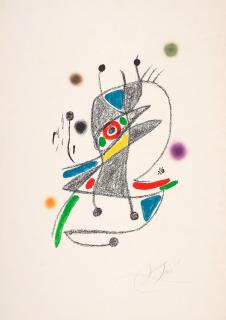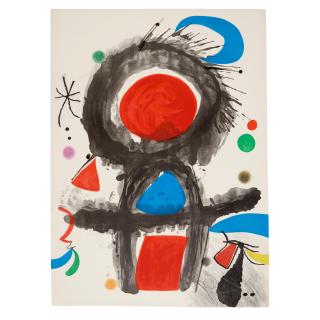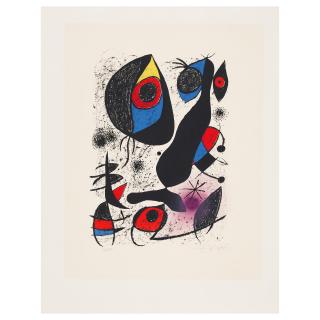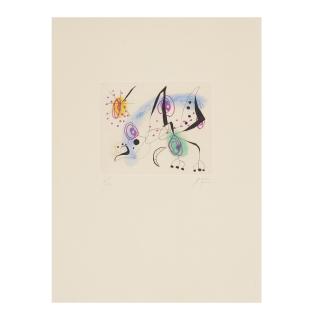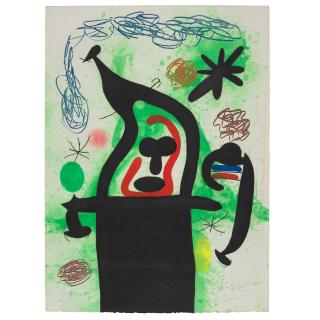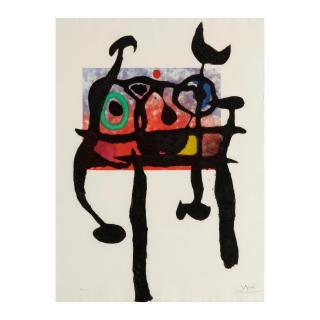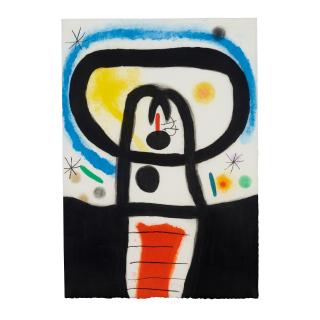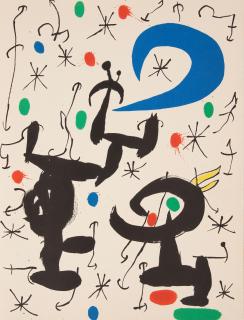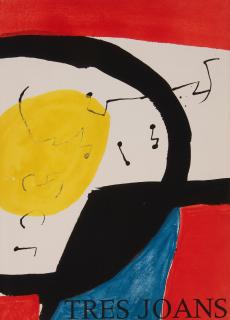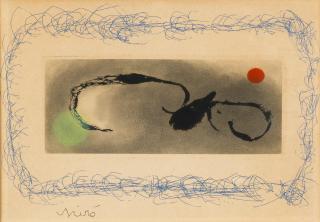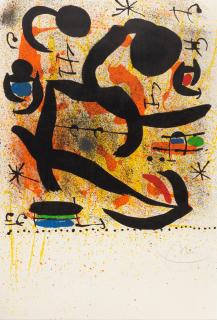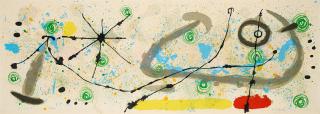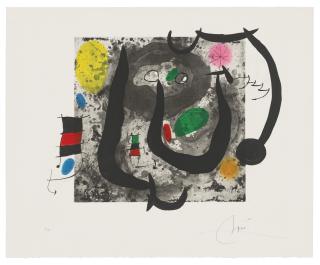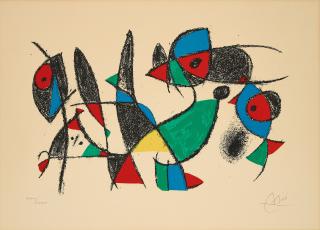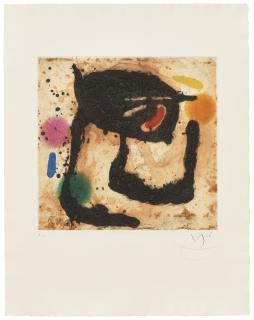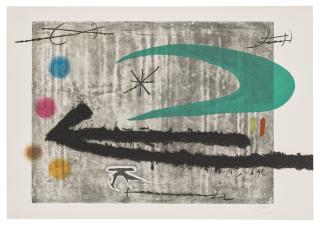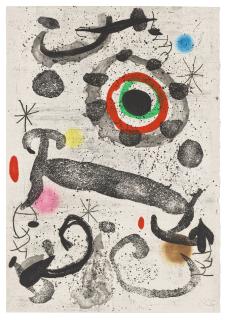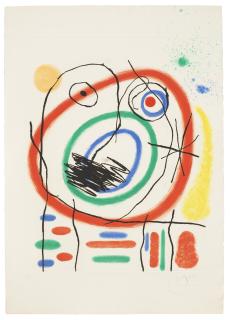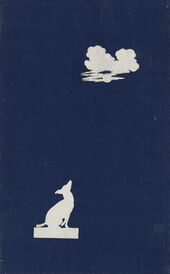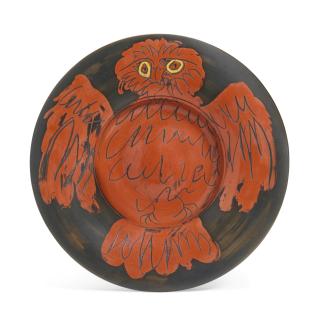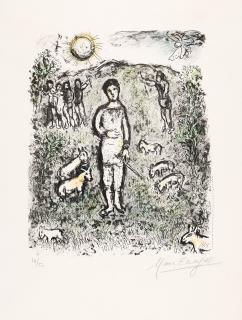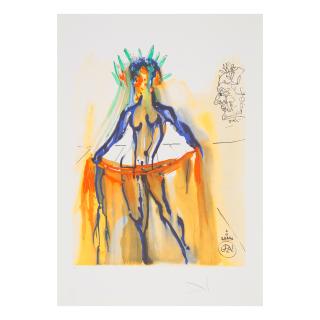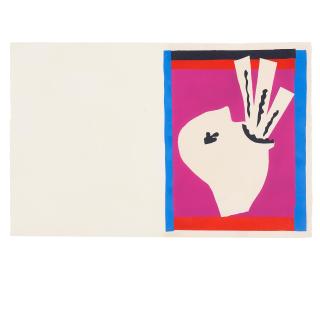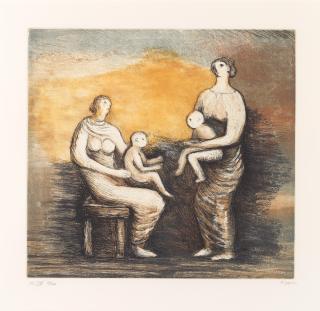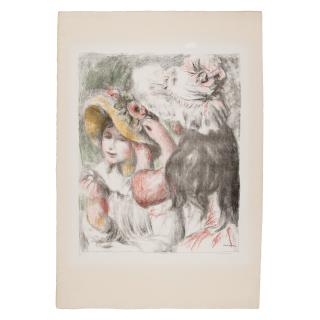Joan Miró Barcelona, Spain 1893 - 1983 Palma, Spain
The artist Joan Miró
- One of the most famous artists of the 20th century.
- Joined the surrealist circle around Breton and was fond of Dadaism.
- His words »murder of art show« his attitude to bourgeois art.
The 1920s and -30s gave rise to groundbreaking art movements such as Fauvism and Cubism, as well as Dadaism and Surrealism. Their followers thus ushered in a new era, on the basis of which unprecedented works could be created. Joan Miró can undoubtedly be counted among one of the most influential figures of this period. His strong colors and the clear lines of his minimalist figures are what on the one hand made him belong to the different, partly overlapping styles and on the other hand brought him high recognition value.
Born in Barcelona in 1893, Miró spent a lot of time in Paris and decided to move there in 1921. Thus he became acquainted with the modern Parisian art scene – he came into contact with both Picasso and André Breton, whose Surrealist movement he eventually joined. Within the group, however, he remained more of a marginal figure. At the beginning of his career, the young painter was still more oriented towards Fauvism and Cubism, from which he turned away in the 1930s in favor of his style, later considered characteristic.
It was precisely at this time that Miró's fame began to grow internationally. While Miró is known primarily for his paintings, his oeuvre also includes sculptures, ceramics, stained glass windows, and tapestries that can be seen or were seen, for example, at the UNESCO building in Paris, in the streets of his native Barcelona, or at the World Trade Center. Miró died at the age of 90, after his anniversary this year was extensively celebrated by the art world with many exhibitions and honors.
His famous bon mot »assassinat de la peinture« (Engl: the assassination of art) represents an exaggeration of the Dadaist understanding of the bourgeois art of the time and illustrates Miró's desire for a reformation of the prevailing, accepted concept of art of the 1930s - that he and his work would play a decisive role in this, Miró had probably not yet dreamed of at that time.
Der Künstler Joan Miró
- Einer der bekanntesten Künstler des 20. Jahrhunderts.
- Schloss sich dem surrealistischen Kreis um Breton an und war dem Dadaismus zugetan.
- Seine Worte »Ermordung der Kunst« offenbaren seine Haltung zur bourgeoisen Kunst.
Die 1920er und -30er Jahre brachten bahnbrechende Kunstrichtungen wie den Fauvismus und den Kubismus sowie den Dadaismus und den Surrealismus hervor. Ihre Anhänger läuteten so eine neue Ära ein, auf deren Grundlage nie zuvor dagewesene Arbeiten entstehen konnten. Joan Miró kann zweifellos zu einer der einflussreichsten Personen dieser Zeit gezählt werden. Seine kräftigen Farben und die klare Linienführung seiner minimalistischen Figuren sind es, die ihn einerseits zu den verschiedenen, teils überlappenden Stilrichtungen zuordnen lassen und ihm andererseits hohen Wiedererkennungswert brachten.
Der 1893 in Barcelona geborene Miró verbrachte viel Zeit in Paris und entschied sich 1921 dorthin überzusiedeln. So lernte er die moderne Pariser Kunstszene kennen – er kam sowohl mit Picasso als auch mit André Breton in Berührung, dessen surrealistischer Bewegung er sich schließlich anschloss. Innerhalb der Gruppe blieb er allerdings eher eine Randfigur. Zu Beginn seiner Laufbahn orientierte sich der junge Maler noch eher am Fauvismus und Kubismus, von denen er sich in den 1930er Jahren zugunsten seines später als charakteristisch geltenden Stils abwandte.
Genau in dieser Zeit begann Mirós Ruhm auch auf internationaler Ebene zu wachsen. Miró ist zwar hauptsächlich für seine Gemälde bekannt, doch umfasst sein Œuvre auch Skulpturen, Keramiken, Glasfenster und Wandteppiche, die etwa am UNESCO-Gebäude in Paris, in den Straßen seiner Geburtsstadt Barcelona oder im World Trade Center zu sehen sind bzw. waren. Miró starb im Alter von 90 Jahren, nachdem sein Jubiläum in diesem Jahr von der Kunstwelt ausgiebig mit vielerlei Ausstellungen und Ehrungen gefeiert wurde.
Sein berühmtes Bonmot »assassinat de la peinture« (dt. die Ermordung der Kunst) stellt eine Zuspitzung des dadaistischen Verständnisses der damaligen bourgeoisen Kunst dar und verdeutlicht Mirós Verlangen nach einer Reformierung des vorherrschenden, akzeptierten Kunstbegriffs der 1930er Jahre – dass er und sein Werk maßgeblich daran beteiligt sein würden, hatte sich Miró zu diesem Zeitpunkt vermutlich noch nicht träumen lassen.
Joan Miró in a nutshell
Miró was born on April 20, 1893 in Barcelona, the capital of Catalonia. This is one of 17 autonomous communities in Spain, linguistically and culturally distinct from Spain. Catalonia has always been trying to become independent. Catalan folk art helped shape Miró's early work. Miró died at the age of 90 on December 25, 1983, in Palma on the Mediterranean island of Mallorca. It is the capital of the Balearic Islands, another autonomous community in the country.
Miró's art is known for its abstract forms, surrealist elements and bright colors. He combined organic shapes, lines, circles and stars, suns and moons to create a unique visual language. Many of his works are characterized by a strong emotional impact, which is enhanced by the use of bold colors. In addition, he was distinguished by his spontaneity and simplicity. Miró often sought a childlike, naive expression in his works, painting impulsively and experimentally. He was a pioneer in the use of unusual materials and techniques in the media of collage, sculpture, and ceramics. His works often exude a poetic and mystical quality, integrating symbols and signs that can refer to a variety of meanings.
The price depends greatly on the medium, whether it is a collage, a drawing or a painting. Drawings and smaller, sketch-like paintings can be found in large numbers. They cost a few hundred to a few thousand US dollars and make up the bulk of the works traded. Miró is also one of the most famous modernist painters and is in high demand. Over 160 of his paintings have so far fetched prices of more than $1 million at auction. The most expensive to date, titled Peinture (Étoile Bleue) (1927), was auctioned by Sotheby's in London in the summer of 2012 for nearly 23.6 million British pounds (about $37.3 million at the time).
Miró artistic career was very long and he worked in some common media. It is estimated that there are about 2000 oil paintings, 500 sculptures, 400 ceramics and 5000 collages and drawings. In addition, there are about 3500 graphics. Depending on the time of their creation, they show influences of Cubism, Fauvism and Catalan folk art, later especially Dadaism and Surrealism.
Miró rejected the commercialization of painting, which he believed had been taking place since the Cave Age. Exactly when his saying to murder painting first appeared is not known. What is certain is that it happened before 1927. In that year, Miró's phrase already appears in Maurice Raynal's book on painting. Miró had already abandoned painting (altogether) several times, in the late 1920s and late 1950s, each time for several years, to devote himself to other media such as collage and ceramics. Over the course of his life, his opinion on the subject hardened. In 1973, for example, he painted the five-part series Burnt Canvases, in which he cut out large areas of the canvases with a blowtorch. This was a clear statement for Miró not to focus only on the commercial value of artworks.
Häufige Fragen zu Joan Miró
Miró wurde am 20. April 1893 in Barcelona geboren, der Hauptstadt Kataloniens. Dies ist eine von 17 autonomen Gemeinschaften in Spanien, die sich sprachlich und kulturell von Spanien unterscheidet. Seit jeher versucht Katalonien, unabhängig zu werden. Die katalanische Volkskunst prägte Mirós Frühwerk mit. Gestorben ist Miró am 25. Dezember 1983 90-jährig in Palma auf der Mittelmeerinsel Mallorca. Sie ist Hauptstadt der Balearen, einer weiteren autonomen Gemeinschaft des Landes.
Mirós Kunst ist bekannt für ihre abstrakten Formen, surrealistischen Elemente und leuchtenden Farben. Er kombinierte organische Formen, Linien, Kreise und Sterne, Sonnen und Monde zu einer einzigartigen Bildsprache. Viele seiner Werke zeichnen sich durch eine starke emotionale Wirkung aus, die durch die Verwendung kräftiger Farben noch verstärkt wird. Darüber hinaus zeichnete er sich durch seine Spontaneität und Einfachheit aus. Oft suchte Miró in seinen Werken einen kindlichen, naiven Ausdruck und malte impulsiv und experimentell. Er war ein Pionier in der Verwendung ungewöhnlicher Materialien und Techniken in den Medien Collage, Skulptur und Keramik. Seine Werke strahlen oft eine poetische und mystische Qualität aus und integrieren Symbole und Zeichen, die auf eine Vielzahl von Bedeutungen verweisen können.
Der Preis hängt stark vom Medium ab, ob es eine Collage, eine Zeichnung oder ein Gemälde ist. Zeichnungen und kleinere, skizzenartige Malereien finden sich zahlreich. Sie kosten wenige hundert bis einige tausend US-Dollar und machen den Großteil der gehandelten Werke aus. Miró ist zugleich einer der berühmtesten Maler der Moderne und sehr gefragt. Über 160 seiner Gemälde erzielten bisher bei Auktionen Preise von mehr als 1 Million US-Dollar. Das bisher teuerste mit dem Titel Peinture (Étoile Bleue) (1927) versteigerte Sotheby’s in London im Sommer 2012 für fast 23,6 Millionen britische Pfund (damals etwa 37,3 Millionen US-Dollar).
Miró künstlerische Karriere war sehr lang und er arbeitete in einigen gängigen Medien. Geschätzt gibt es etwa 2000 Ölgemälde, 500 Skulpturen, 400 Keramiken und 5000 Collagen und Zeichnungen. Dazu kommen noch circa 3500 Grafiken. Je nach Entstehungszeit weisen sie Einflüsse des Kubismus, Fauvismus und der katalanischen Volkskunst, später vor allem des Dadaismus und Surrealismus auf.
Miró lehnte die Kommerzialisierung der Malerei, die sich seiner Meinung nach seit dem Höhlenzeitalter vollzog, ab. Wann genau sein Spruch, die Malerei zu ermorden, zum ersten Mal auftauchte, ist nicht bekannt. Sicher ist, dass es vor 1927 geschah. In diesem Jahr taucht der Satz von Miró bereits in Maurice Raynals Buch über die Malerei auf. Miró hatte bereits mehrfach, Ende der 1920er und Ende der 1950er, jeweils für mehrere Jahre die Malerei (ganz) aufgegeben, um sich anderen Medien wie der Collage und der Keramik zu widmen. Im Laufe seines Lebens verhärtete sich seine Meinung zu diesem Thema. 1973 malte er beispielsweise die fünfteilige Serie Verbrannte Leinwände, in denen er große Flächen der Leinwände mit einer Lötlampe herausschnitt. Dies war für Miró ein klares Statement, sich nicht nur auf den kommerziellen Wert von Kunstwerken zu konzentrieren.
Joan Miró quotes
Zitate von Joan Miró
Joan Miró in News and Exhibitions
Romantic Surrealism
A penchant for dream worlds, the night and a special feeling for nature: the art and poetry of Romanticism were among the most important sources of inspiration for Surrealism. In Rendezvous of Dreams. Surrealism and German Romanticism, the connection is presented in great detail. The exhibition opens on June 13 at the Hamburger Kunsthalle.
Joan Miró in News and Exhibitions
Der romantische Surrealismus
Der Hang zu Traumwelten, zur Nacht und zu einem besonderen Naturgefühl: Die Kunst und Poesie der Romantik gehörten zu den wichtigsten Inspirationsquellen des Surrealismus. In Rendezvous der Träume. Surrealismus und deutsche Romantik werden die Verbindung detailreich vorgestellt. Die Ausstellung eröffnet am 13. Juni in der Hamburger Kunsthalle.

